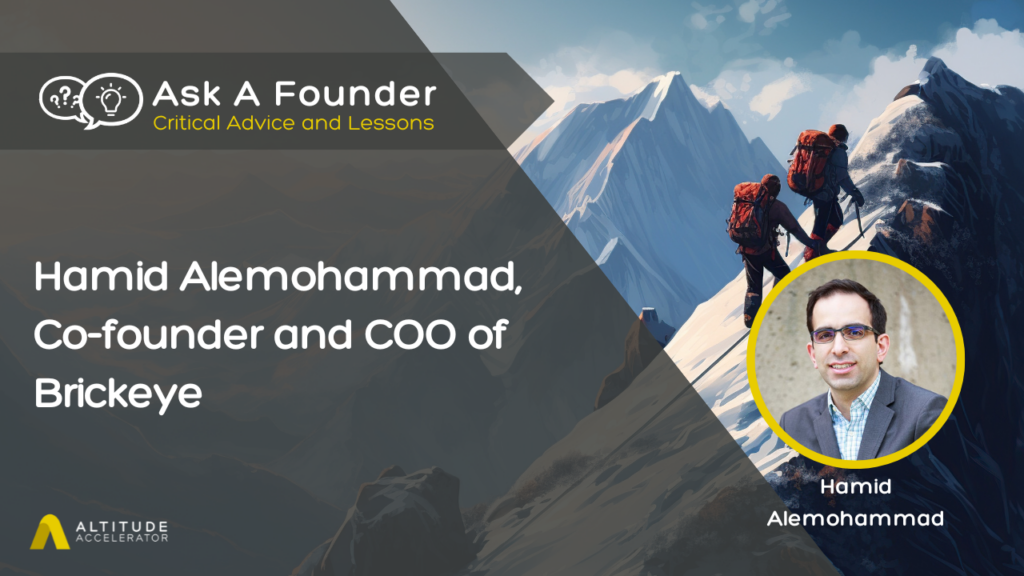Home » Ask a Founder Series: Hamid Alemohammad, COO and Co-Founder of Brickeye
Ask a Founder Series: Hamid Alemohammad, COO and Co-Founder of Brickeye

originally published: 2024-07-22 16:53:49
Hamid Alemohammad, COO and Co-Founder of Brickeye, recently shared his entrepreneurial journey and insights during the “Ask A Founder” session hosted by Altitude Accelerator. The session provided lessons learned, practical advice, and personal anecdotes for aspiring startup founders.
Brickeye’s Approach to Project Management
Brickeye is a construction tech platform which operates similarly to a smart home system but is tailored for construction sites. The company began as a hardware firm and has evolved into a comprehensive platform offering both hardware and software solutions. These solutions include IoT devices and sensors that collect data to enhance productivity, efficiency, and risk management in construction projects. Alemohammad shared the company’s expertise in creating rugged products for harsh environments has been a key differentiator.
Currently, they serve a variety of construction projects, including high-rise, mid-rise, and heavy civil infrastructure projects funded by government investments. The platform generates data from sensors and IoT devices placed on construction sites, which is then captured in the cloud. Their software performs analytics to provide metrics on productivity, efficiency, risk, and other crucial factors for customers.
A Long Winding Journey to Scale
The early days saw Brickeye working with Altitude Accelerator in 2015. At that time, the company was just three people working out of a small office in Waterloo. Altitude Accelerator became a turning point, offering support when many others didn’t understand Brickeye’s hardware-centric approach. Through Altitude, Brickeye connected with advisors and investors, eventually raising their first round of capital, which was crucial for growth.
Although Brickeye was founded about ten years ago, it wasn’t until 2017 that they truly launched the company after raising sufficient capital to scale. Brickeye’s headquarters are in Toronto, with additional offices in Vancouver and Tennessee. Despite their global reach, most customers are based in North America.
Brickeye originated as a hardware company with a path influenced by the founders’ backgrounds in hardware. However, they soon realized that to scale effectively, they would need to add value beyond hardware. This led them to develop a software layer which transformed their product into a comprehensive platform.
The transition from a hardware-focused company to one that integrates software solutions was a strategic move. Alemohammad emphasized the necessity of adding value through software to scale the business effectively. “Hardware at the end of the day is commoditized,” he explained. Before they could change industries and develop a new solution to their problems, Brickeye’s first step to tackle was fundraising.
Navigating the Challenges of Startup Financing
Financing a startup, especially one with a hardware component, is challenging. Alemohammad shared his strategy of leveraging grants extensively. “We had this engine of grant writing in the company; we applied for any kind of grant that was available,” he noted. This approach helped them bridge the funding gap before securing significant investment. Their first round of dilutive funding was essential, and as a former grant advisor, Alemohammad leveraged his experience to tap into various grant programs available in Canada. These grants played a vital role in sustaining and growing his business in the early stages.
Alongside the challenge of gaining funds is financial management. Alemohammad emphasized cash flow management as the highest priority for any startup before tackling the large challenge of raising capital. He emphasized, “As a founder, you need to have a little bit more than basic knowledge of accounting, cash flow management, and financial planning.”
Alemohammad also commented on the idea of failing fast to learn fast; to learn lessons early in the startup process and to avoid any serious damage in the later stages, “You need to be efficient; you need to be lean, and you need to do it fast– fail fast and learn fast because you’re basically figuring out how to build the business at that time.”
The Importance of Strong Teams and Raising Capital
Brickeye’s capital-raising journey began in earnest in 2017, and the company has since attracted significant investment, including a recent $10 million round led by Business Development Bank of Canada (BDC). Alemohammad credited Altitude Accelerator for playing a pivotal role in their early stages. “Altitude was unique in they accepted us when many others didn’t,” he said, praising Entrepreneurs-in-Residence like Geoff Simonett for their valuable support in financial planning and strategy.
He commented on the crucial part the founders play in generating early capital by taking on tough roles in a startup that will pay off in the long run. “All startups at the beginning are founder-led sales. Founders need to sell at the earliest stages because you don’t have capital to hire a VP of sales.” Eventually, Brickeye was able to successfully raise capital through venture capital and angel investors.
Alemohammad also talks about the value of having a strong and qualified team as he discusses the scaling and development of employees. Hiring the right people at the right time is crucial for startup success. He emphasized the importance of a diversified founding team and hiring employees who can thrive in a chaotic, and uncertain startup environment.
“What’s important is that you need people who can operate in those environments. There are great people who work in stable companies. They excel, they flourish, but they might not be a fit for a startup company where everything is on the table,” he said, underscoring the need for agility and adaptability in early-stage teams.
He also emphasized the role of company culture and the importance of chemistry. “My definition of company culture is people. Defining and writing policies around company culture doesn’t really work. When you build an environment that is friendly, cooperative, and rewarding, you can call it a company culture.” He is insistent that finding the right people for the right roles is foundational, “It’s crucial to pick the right roles and skills at the beginning, when you go from founder level to expanding the team.”
Customer Development, Discovery, and Validation
Alemohammad stressed the criticality of the customer development process, citing Steve Blank’s “Startup Owner’s Manual” as a foundational resource. He recounted their initial misstep of building a product without sufficient market validation, leading to costly pivots. “You need to go through what’s called a customer development process; you build a business by product and offering to solve a problem that’s big enough for any business, regardless of if it’s a venture-backed business or a small family-owned business.” he advised. This process involves deep customer discovery and validation before jumping into product development.
He brought light to customer perspectives and the uncertainty and issues they may face with a product, “Many times, customers don’t realize they have a problem. It’s important to engage with them to identify and clarify the issues they face and then present your solution to address them.”
One of the major lessons Alemohammad learned was the importance of the customer development process. Initially, he made the mistake of jumping straight into product development without fully understanding our target market, assuming his IoT system would be perfect for the oil and gas industry, only to realize later their assumptions were flawed.
The correct approach involved deep diving into customer discovery to understand the problem comprehensively before developing the product. He revealed, “Early customers, or ‘early evangelists’ are important as they help validate assumptions and provide insights to refine the product.” Once Brickeye understood their customers and the key problems they faced, they were able to develop products that provided the right solutions.
Iterative Product Development
As valuable as a strong team can be, knowing your customers is just as important. The concept of minimum viable product (MVP) and iterative development is central to Brickeye’s approach. Alemohammad highlighted the importance of rapid iteration and customer feedback in refining their products. “Build it fast and then try it; as soon as you realize these are the features your customers want, then you do it properly. You need to build the minimum viable product that is enough for a customer to see, evaluate and then give you feedback.”
This led to one of Brickeye’s significant achievements in developing expertise and creating products necessary for dealing with projects in harsh environments. Construction sites and remote locations are environments that make it challenging to set up reliable systems. Their focus on ensuring ruggedness and reliability in such conditions became a core strength of the company.
Alemohammad advocated for a balance between speed and thoroughness in product development. On the development of an idea, he indicated, “You have a vision, and at the end of the day it’s a hypothesis. You think that by building this product you can serve this market and you can start a business.”
Final Thoughts and Lessons from the Field
One critical moment was when Brickeye pivoted their target focus from the oil and gas industry to construction tech. Through networking and advisor recommendations, Alemohammad discovered a real problem in the construction industry their technology could solve.
This shift allowed the company to validate their product, attract investors, and build a sustainable business. He states, “You constantly do this loop until you understand the market, customer journey, market size, path to selling the product, and the different players in your buying journey.”
Alemohammad’s reflection on Brickeye’s journey provided a wealth of meaningful insights for entrepreneurs. His emphasis on customer-centric development, strategic financing, and building a resilient team resonated throughout the session. As he put it, “At the end of the day, a startup is a journey, and it takes a lot of time and effort to get it done step by step.”
ABOUT: Massimo Bozzo is a fourth-year professional writing and communications student at University of Toronto Mississauga who enjoys writing. He’s had some works published through campus publications and is currently working at Altitude Accelerator as the Interactive Media Writer. He looks forward to learning more about blog and article writing and wishes to gain experience in the marketing and communications fields.
Altitude Accelerator
https://altitudeaccelerator.ca/
Altitude Accelerator is a not-for-profit innovation hub and business incubator for Brampton, Mississauga, Caledon, and other communities in Southern Ontario. Altitude Accelerators’ focus is to be a dynamic catalyst for tech companies. We help our companies grow faster and stronger. Our strength is our proven ability to foster growth for companies in Advanced Manufacturing, Internet of Things, Hardware & Software, Cleantech and Life Sciences. Our team consists of more than 100 expert advisors, industry, academic, government partners. The team helps companies in Advanced Manufacturing, Internet of Things, Hardware & Software, Cleantech and Life Sciences to commercialize their products and get them to market faster.


